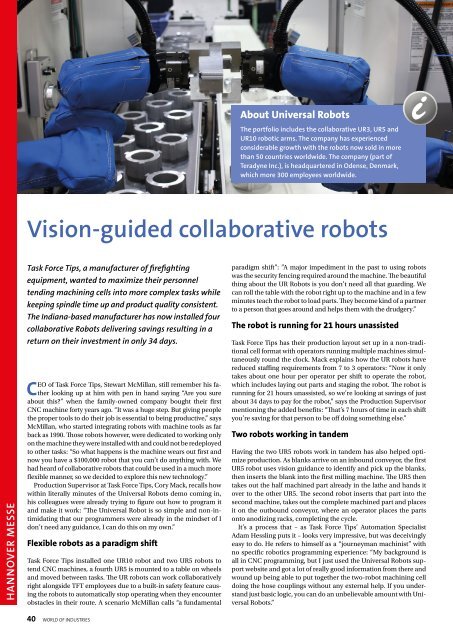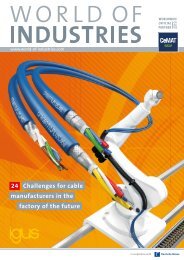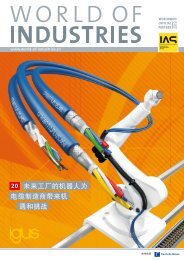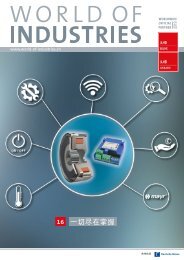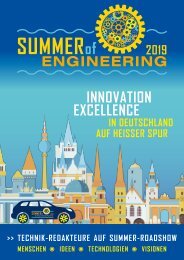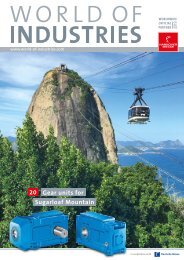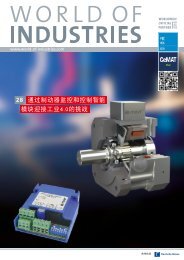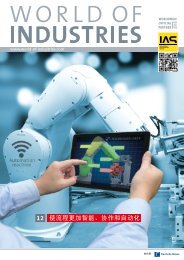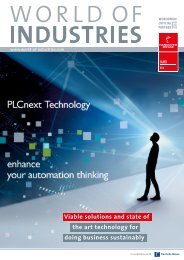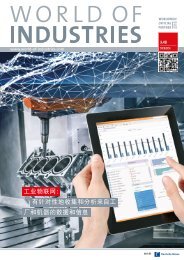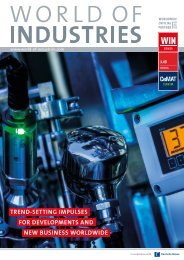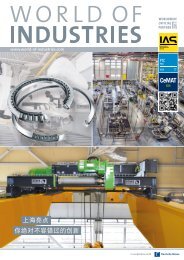world of industries 3/2017 (EN)
world of industries 3/2017 (EN)
world of industries 3/2017 (EN)
- TAGS
- world
- industries
Create successful ePaper yourself
Turn your PDF publications into a flip-book with our unique Google optimized e-Paper software.
About Universal Robots<br />
The portfolio includes the collaborative UR3, UR5 and<br />
UR10 robotic arms. The company has experienced<br />
considerable growth with the robots now sold in more<br />
than 50 countries <strong>world</strong>wide. The company (part <strong>of</strong><br />
Teradyne Inc.), is headquartered in Odense, Denmark,<br />
which more 300 employees <strong>world</strong>wide.<br />
Vision-guided collaborative robots<br />
HANNOVER MESSE<br />
Task Force Tips, a manufacturer <strong>of</strong> firefighting<br />
equipment, wanted to maximize their personnel<br />
tending machining cells into more complex tasks while<br />
keeping spindle time up and product quality consistent.<br />
The Indiana-based manufacturer has now installed four<br />
collaborative Robots delivering savings resulting in a<br />
return on their investment in only 34 days.<br />
CEO <strong>of</strong> Task Force Tips, Stewart McMillan, still remember his father<br />
looking up at him with pen in hand saying “Are you sure<br />
about this?” when the family-owned company bought their first<br />
CNC machine forty years ago. “It was a huge step. But giving people<br />
the proper tools to do their job is essential to being productive,” says<br />
McMillan, who started integrating robots with machine tools as far<br />
back as 1990. Those robots however, were dedicated to working only<br />
on the machine they were installed with and could not be redeployed<br />
to other tasks: “So what happens is the machine wears out first and<br />
now you have a $100,000 robot that you can’t do anything with. We<br />
had heard <strong>of</strong> collaborative robots that could be used in a much more<br />
flexible manner, so we decided to explore this new technology.”<br />
Production Supervisor at Task Force Tips, Cory Mack, recalls how<br />
within literally minutes <strong>of</strong> the Universal Robots demo coming in,<br />
his colleagues were already trying to figure out how to program it<br />
and make it work: “The Universal Robot is so simple and non-intimidating<br />
that our programmers were already in the mindset <strong>of</strong> I<br />
don’t need any guidance, I can do this on my own.”<br />
Flexible robots as a paradigm shift<br />
Task Force Tips installed one UR10 robot and two UR5 robots to<br />
tend CNC machines, a fourth UR5 is mounted to a table on wheels<br />
and moved between tasks. The UR robots can work collaboratively<br />
right alongside TFT employees due to a built-in safety feature causing<br />
the robots to automatically stop operating when they encounter<br />
obstacles in their route. A scenario McMillan calls “a fundamental<br />
paradigm shift”: ”A major impediment in the past to using robots<br />
was the security fencing required around the machine. The beautiful<br />
thing about the UR Robots is you don’t need all that guarding. We<br />
can roll the table with the robot right up to the machine and in a few<br />
minutes teach the robot to load parts. They become kind <strong>of</strong> a partner<br />
to a person that goes around and helps them with the drudgery.”<br />
The robot is running for 21 hours unassisted<br />
Task Force Tips has their production layout set up in a non-traditional<br />
cell format with operators running multiple machines simultaneously<br />
round the clock. Mack explains how the UR robots have<br />
reduced staffing requirements from 7 to 3 operators: “Now it only<br />
takes about one hour per operator per shift to operate the robot,<br />
which includes laying out parts and staging the robot. The robot is<br />
running for 21 hours unassisted, so we’re looking at savings <strong>of</strong> just<br />
about 34 days to pay for the robot,” says the Production Supervisor<br />
mentioning the added benefits: “That’s 7 hours <strong>of</strong> time in each shift<br />
you’re saving for that person to be <strong>of</strong>f doing something else.”<br />
Two robots working in tandem<br />
Having the two UR5 robots work in tandem has also helped optimize<br />
production. As blanks arrive on an inbound conveyor, the first<br />
UR5 robot uses vision guidance to identify and pick up the blanks,<br />
then inserts the blank into the first milling machine. The UR5 then<br />
takes out the half machined part already in the lathe and hands it<br />
over to the other UR5. The second robot inserts that part into the<br />
second machine, takes out the complete machined part and places<br />
it on the outbound conveyor, where an operator places the parts<br />
onto anodizing racks, completing the cycle.<br />
It’s a process that – as Task Force Tips’ Automation Specialist<br />
Adam Hessling puts it – looks very impressive, but was deceivingly<br />
easy to do. He refers to himself as a “journeyman machinist” with<br />
no specific robotics programming experience: “My background is<br />
all in CNC programming, but I just used the Universal Robots support<br />
website and got a lot <strong>of</strong> really good information from there and<br />
wound up being able to put together the two-robot machining cell<br />
doing the hose couplings without any external help. If you understand<br />
just basic logic, you can do an unbelievable amount with Universal<br />
Robots.”<br />
40 WORLD OF INDUSTRIES


